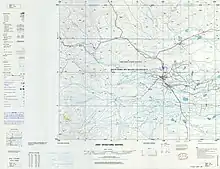K'a-shih
English

Map including K'a-shih (Kashgar) (DMA, 1983)
Etymology
From Mandarin 喀什, Wade–Giles romanization: Kʻa¹-shih².[1][2]
Proper noun
K'a-shih
- Alternative form of Kashi (Kashgar)
- 1966, Translations on People's Republic of China, United States Joint Publications Research Service, →OCLC, page 148:
- I. Geological and Topographical Conditions
Geologically speaking, K'a-shih inland delta belongs to the western most end of Tarim Table. It is primarily sha-ch'e syneklise.
- 1973, Chiao-min Hsieh, “Transportation”, in Christopher L. Salter, editor, Atlas of China, McGraw-Hill, Inc., →ISBN, →LCCN, →OCLC, →OL, page 74, column 2:
- From Peking air routes extend northward to Ch’i-ch’i-ha-erh in Manchuria, southeastward to Shanghai, southward to the island of Hainan, and westward to K’a-shih in Sinkiang.
- 1976, Chuen-Yan David Lai, “Developments of Cotton Cultivation in Sinkiang”, in Pacific Viewpoint, volume 17, number 2, , archived from the original on 30 June 2020, page 162:
- K'a-shih has the most extensive cotton-growing area which amounted to 950 000 mou (6.3 million ares) in 1965.
Translations
Kashi — see Kashi
See also
References
- Kashgar, (Wade-Giles romanization) K’a-shih, in Encyclopædia Britannica
- Shabad, Theodore (1972) “Index”, in China's Changing Map, New York: Frederick A. Praeger, →LCCN, →OCLC, pages 345, 354:
- Chinese place names are listed in three common spelling styles: […] (1) the Post Office system, […] (2) the Wade-Giles system, […] shown after the main entry […] (3) the Chinese Communists' own Pinyin romanization system, which also appears in parentheses […] Kashgar (K’a-shih, Kashi)
Further reading
- “K’a-shih”, in Merriam-Webster Online Dictionary, Springfield, Mass.: Merriam-Webster, 1996–present.
This article is issued from Wiktionary. The text is licensed under Creative Commons - Attribution - Sharealike. Additional terms may apply for the media files.